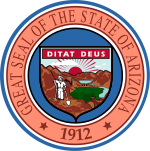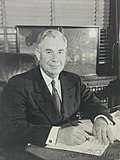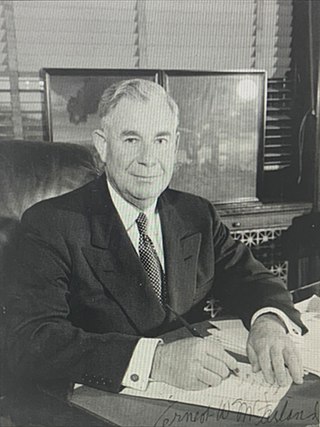
Ernest William McFarland was an American politician, jurist and, with Warren Atherton, one of the "Fathers of the G.I. Bill." He is the only Arizonan to serve in the highest office in all three branches of Arizona government, two at the state level, one at the federal level. He was a Democratic U.S. Senator from Arizona from 1941 to 1953 before he was the tenth governor of Arizona from 1955 to 1959. Finally, McFarland sat as chief justice on the Arizona Supreme Court in 1968.

The 1968 United States Senate elections were elections for the United States Senate which coincided with the presidential election of the same year. Although Richard Nixon won the presidential election narrowly, the Republicans picked up five net seats in the Senate. Republicans would gain another seat after the election when Alaska Republican Ted Stevens was appointed to replace Democrat Bob Bartlett.

The 1964 United States Senate elections coincided with the election of President Lyndon B. Johnson by an overwhelming majority, to a full term. His Democratic Party picked up a net two seats from the Republicans. As of 2022, this was the last time either party has had a two-thirds majority in the Senate, which would have hypothetically allowed the Senate Democrats to override a veto, propose constitutional amendments, convict and expel certain officials, or invoke cloture without any votes from Senate Republicans. In practice, however, internal divisions effectively prevented the Democrats from doing so. The Senate election coincided with Democratic gains in the House in the same year.

The 1952 United States Senate elections was an election for the United States Senate which coincided with the election of Dwight D. Eisenhower to the presidency by a large margin. The Republicans took control of the senate by managing to make a net gain of two seats, which was reduced to one when Wayne Morse (R-OR) became an independent. The Republicans still held a majority after Morse's switch. This election was the second time in history that the party in power lost their majority and the Senate Majority Leader lost his own re-election bid. This was the last time the Senate changed hands in a presidential election year until 1980 and the last time the Republicans won control of the Senate until 1980.

The 2004 United States Senate election in South Dakota was held on November 2, 2004. Incumbent Democratic U.S. Senator and Senate Minority Leader Tom Daschle ran for re-election to a fourth term, but was narrowly defeated by Republican John Thune.

Electoral history of Barry Goldwater, United States Senator from Arizona and Republican Party nominee for President of the United States during 1964 election

The 1952 United States Senate election in Arizona was held on November 4, 1952. Incumbent Democratic U.S. Senator and Senate Majority Leader Ernest McFarland ran for re-election to a third term, but was defeated by the Republican nominee and future candidate for President of the United States, Barry Goldwater.

The 1934 United States Senate elections in Arizona took place on November 3, 1934. Incumbent Democratic U.S. Senator Henry F. Ashurst ran for reelection to a fifth term, defeating Republican nominee Joseph Edward Thompson in the general election by a wide margin.

The 1940 United States Senate elections in Arizona took place on November 5, 1940. Incumbent Democratic U.S. Senator Henry F. Ashurst ran for reelection to a sixth term, but was defeated in the Democratic primary to challenger Ernest McFarland.

The 1946 United States Senate elections in Arizona took place on November 5, 1946. Incumbent Democratic U.S. Senator Ernest McFarland ran for reelection to a second term, easily defeating his Republican challenger Ward S. Powers in the general election.

The 1964 United States Senate election in Arizona took place on November 3, 1964. Incumbent Republican U.S. Senator Barry Goldwater decided not to run for reelection to a third term, instead running for President of the United States as the Republican Party nominee against Lyndon B. Johnson. Governor of Arizona Paul Fannin ran unopposed in the Republican primary, and defeated Democratic nominee Roy Elson, who was a staff member for U.S. Senator Carl Hayden until Hayden's retirement in 1969.

The 1920 United States Senate elections in Arizona took place on November 2, 1920. Incumbent Democratic U.S. Senator Marcus A. Smith ran for reelection to a third term, but was defeated by former Delegate to the U.S. House of Representatives from the Arizona Territory Ralph H. Cameron in the general election. Cameron would become the first Republican elected to the office of U.S. Senator from Arizona since the state joined the union in 1912. The same year, Republican Governor Thomas Edward Campbell was reelected to a second term.

The 1974 United States Senate election in Arizona took place on November 5, 1974. Incumbent Republican U.S. Senator Barry Goldwater decided to run for reelection to a second consecutive term, after returning to the U.S. Senate in 1968 following his failed Presidential run in 1964 against Lyndon B. Johnson. Goldwater defeated Democratic Party nominee philanthropist Jonathan Marshall in the general election.
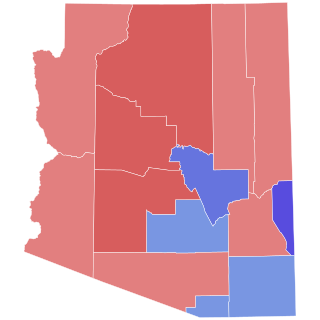
The 1968 United States Senate election in Arizona took place on November 5, 1968. Incumbent Democratic U.S. Senator Carl Hayden did not run for reelection to an eighth term, with his longtime staff member Roy Elson running as the Democratic Party nominee to replace him. Elson was defeated by a wide margin, however, by former U.S. Senator and 1964 Republican presidential nominee Barry Goldwater. Prior to Goldwater's election, the seat had been held for decades by the Democratic Party under Carl Hayden, but after this election remained in Republican Party control continuously for 52 years, until Democrat Mark Kelly won in the 2020 special election.

The 1962 United States Senate election in Arizona took place on November 6, 1962. Incumbent Democratic U.S. Senator Carl Hayden ran for reelection to a seventh term, defeating Republican State Senator Evan Mecham in the general election. Mecham became Governor of Arizona more than two decades later, and was subsequently impeached and removed from office.

The 1980 United States Senate election in Arizona took place on November 4, 1980. Incumbent Republican Senator Barry Goldwater decided to run for reelection to a third consecutive term, after returning to the Senate in 1968 following his failed presidential run in 1964 against Lyndon B. Johnson. Despite Republican presidential nominee Ronald Reagan's landslide win in Arizona, Goldwater defeated Democratic Party nominee Bill Schulz in the general election by a narrow margin, which later caused Goldwater to decide against running for reelection to a fourth consecutive term. Goldwater won only three counties, including Maricopa County.

The 1916 United States Senate elections in Arizona took place on November 7, 1916. Incumbent Democratic U.S. Senator Henry F. Ashurst ran for reelection to a second term, defeating Republican former Territorial Governor Joseph H. Kibbey in the general election by a comfortable margin.

The 1954 Arizona gubernatorial election took place on November 2, 1954. Incumbent Governor John Howard Pyle, the first Republican elected to the office in two decades, ran for reelection for a third term.

The 1958 Arizona gubernatorial election took place on November 4, 1958. Incumbent Governor Ernest McFarland decided not to run for reelection and instead unsuccessfully challenged U.S. Senator Barry Goldwater in attempt to return to the United States Senate.
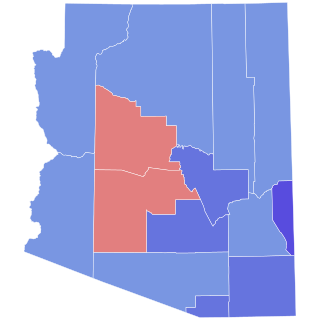
The 1964 Arizona gubernatorial election took place on November 3, 1964. Incumbent Governor Paul Fannin decided not to run for reelection to a fourth term as governor, instead deciding to successfully run for the United States Senate when incumbent U.S. Senator Barry Goldwater decided to run for President of the United States.

